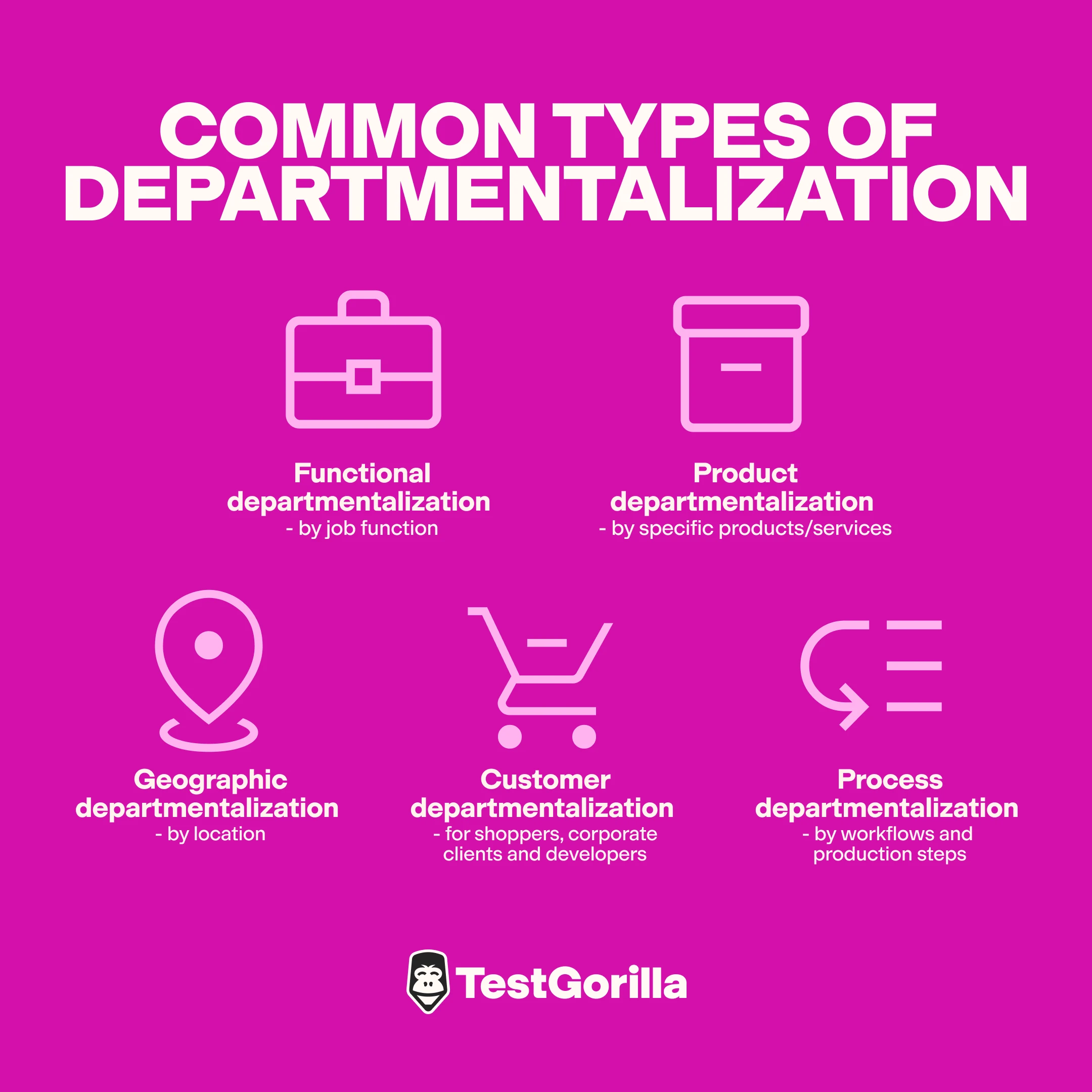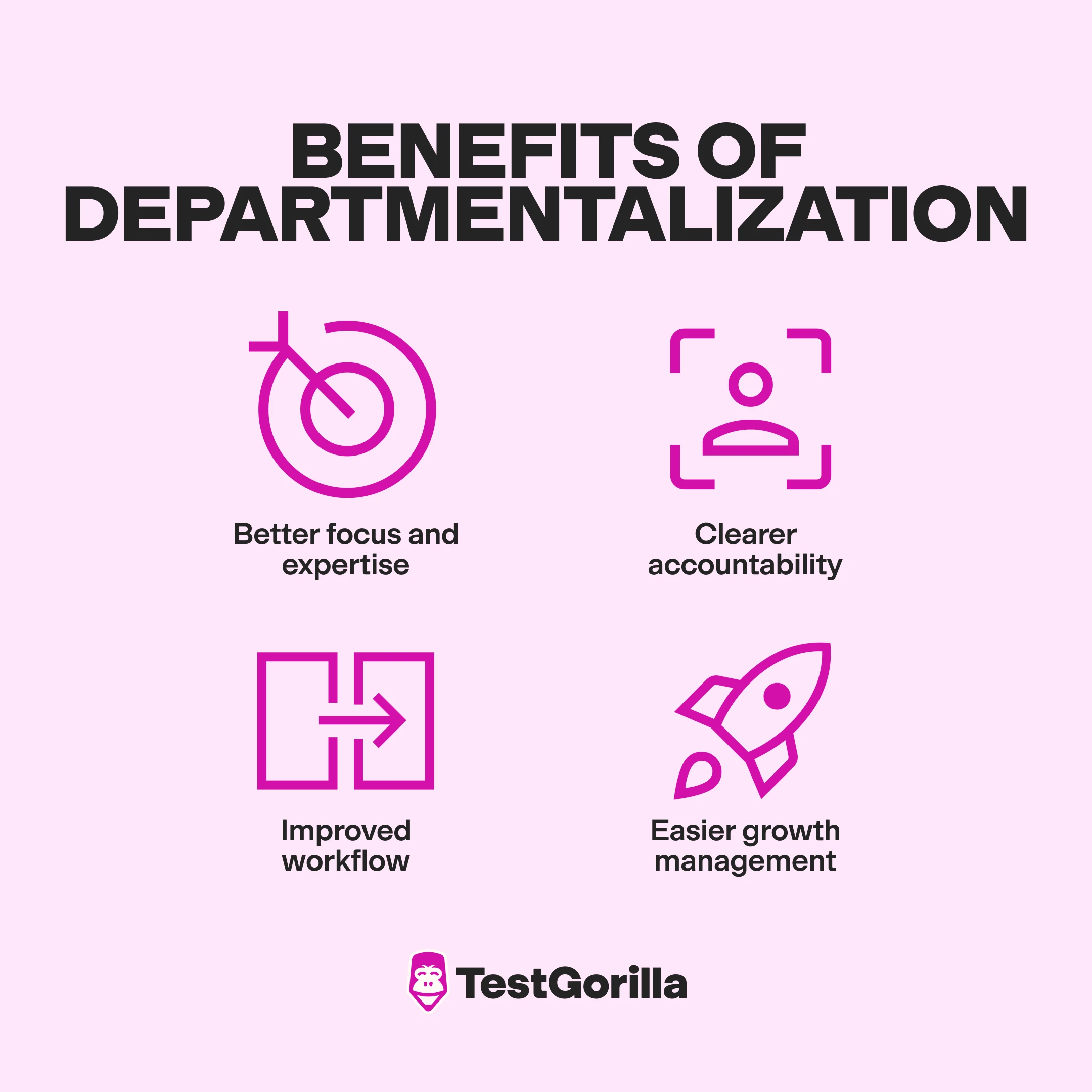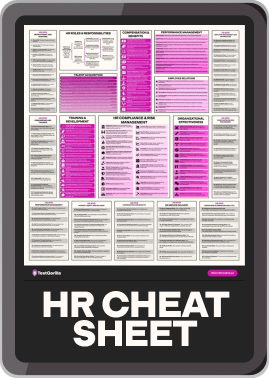Departmentalization is the process of splitting an organization into distinct units or departments where similar jobs and functions are grouped together. It's a way to organize work, responsibilities, and people to help your business run more efficiently.
For example, a growing tech company might have separate departments for:
Product development - where engineers build and improve the product
Marketing - where the team handles promotion and brand awareness
Customer support - where specialists help users solve problems
Sales - where representatives work with potential customers
Common types of departmentalization
Every business can structure its departments differently based on what works best for its organizational goals. Here are the main ways you can organize your departments:
Type | Description | Example | Why it works | Best for |
Functional departmentalization | Functional departments group employees by job function (e.g., marketing, finance, or human resources). | Apple: Design team focuses on aesthetics, while engineering handles tech | Helps businesses focus on specific areas of expertise | Companies needing deep expertise |
Product departmentalization | Teams are categorized around specific products or services. | P&G: Separate teams for Olay (beauty), Pampers (baby care), Vicks (health) | Tailors strategies to each product | Businesses with diverse product lines |
Geographic departmentalization | Teams are structured by locations they serve to adapt to regional markets. | McDonald's: Regional teams customize menus (e.g., rice dishes in Asia) | Enhances local relevance | Companies with national/global reach |
Customer departmentalization | Groups teams are based on customer segments. | Amazon: Separate teams for shoppers, corporate clients (Amazon Business), and developers (AWS) | Improves customer focus | Businesses serving distinct audiences |
Process departmentalization | Process departments are organized around specific workflows or production steps. | Tesla: Teams for battery production, assembly, quality control | Ensures smooth workflow, high quality | Process-driven industries |
Types of combined departmentalization
Large companies often need more flexibility than a single departmental structure can provide. Combined departmentalization blends different structures to improve efficiency, flexibility, and collaboration in complex organizations. Here are a few types:
Divisional departmentalization
This structure splits a company into multiple divisions, each serving a specific market, product, or region. Within each division, there are identical departments for different functions.
Example: General Electric (GE) has separate divisions for healthcare, power, and aviation. Each division has its own marketing, finance, and production departments – which operate independently.
Multiple departmentalization
In this system, a company is divided into large divisions, but each division structures its departments differently based on its needs. Some may group them by function, while others may use product or process-based departments.
Example: Samsung operates multiple large divisions, including Mobile, Home Appliances, and Semiconductors. Within the Mobile division, teams are organized by product lines (smartphones, tablets, wearables), while the Semiconductor division is structured by manufacturing processes (chip design, fabrication, testing).
Matrix departmentalization
The matrix – or project-based – structure creates bigger functional departments, which are then further divided into smaller, often-temporary teams based on projects. Employees often report to more than one manager: a functional manager and project manager.
Example: At a content agency, a writer might work under the content team while simultaneously working on project teams for specific clients – reporting to the content manager and the clients’ account/project managers.
The best insights on HR and recruitment, delivered to your inbox.
Biweekly updates. No spam. Unsubscribe any time.
Why is departmentalization important?
Clear, focused departments make it easier for your business to grow and run efficiently, with benefits including:
Better focus and expertise: Each department sharpens its skills without distractions. This specialization leads to deeper expertise and stronger results.
Clearer accountability: You always know who’s responsible. If sales drop, the sales team steps up. If customer satisfaction improves, you know who to thank.
Improved workflow: In well-structured teams, work flows naturally. For instance, a software company moves from research to design, development, testing, and customer support without hold-ups. Each team understands its role, keeping workflow processes smooth and efficient.
Easier growth management: As your business scales, clear departments help you grow without chaos. You can expand teams efficiently, train employees in specialized roles, allocate resources wisely, and make decisions faster.
How departmentalization affects hiring and workforce planning
With clear departments, hiring becomes more focused and effective. Here’s how:
Clearer job roles
Departments help you understand departmental roles and create specific job descriptions that set clear expectations. Instead of hiring a general "marketer," you can be more precise:
Content writers for your content marketing team
Data analysts for your marketing analytics group
Campaign managers for your advertising team
Better skill matching
Each department needs different skills – for instance, communication skills, patience, and familiarity with communication tools (like email) are important for customer service departments. Understanding this helps you:
Create targeted job assessments for evaluating candidates
Ask the right interview questions
Set appropriate skill requirements
Recognize when an existing employee may be a good fit for an open role within another department
Smarter resource planning
With structured departments, you can predict hiring needs based on department growth, plan training programs tailored to specific teams, budget effectively for new positions, and identify skills gaps within each unit.
Better cultural considerations
Different departments often develop their own mini-cultures. Your sales team might be high-energy and competitive, while your development team values quiet focus.
Equipped with this knowledge, you can look for those who bring fresh perspectives and complementary strengths to specific departments.
Challenges of departmentalization and how to overcome them
Here's what might go wrong when departmentalizing your business and how you can handle it:
Communication gaps and coordination issues
Teams that don’t coordinate duplicate work, waste resources, and give customers mixed messages. Important updates get lost, leading to confusion and inefficiencies that affect service quality.
How to fix: Set up regular check-ins, use shared tools, and clarify roles to keep teams aligned.
Power struggles and siloed thinking
Departments often compete for resources or recognition, which can slow down progress and create frustration. They may also ignore the bigger picture, leading to roadblocks across the organization.
How to fix: Clearly define each department’s needs and ensure everyone understands the company’s goals, fostering collaboration instead of competition. Recognize shared successes to keep everyone aligned with a common objective.
Slow processes
Too many interdepartmental steps or approvals can make even simple tasks inefficient and time-consuming.
How to fix: Streamline decision-making, reduce unnecessary approvals, and empower teams to move forward with clear guidelines.
Conflicting mini-cultures
Departments sometimes develop their own work styles, priorities, and expectations. While some variation is natural, too much can cause misunderstandings and inefficiencies.
How to fix: Establish company-wide values and guidelines to keep all departments aligned while still allowing flexibility. Interdepartmental collaboration and team-building activities help bridge these gaps, creating a more unified work environment.
FAQs
What is departmentation?
Departmentation refers to the process of creating departments based on function, product, geography, or customer needs. This involves deciding how to divide the organization, including its people, work, and responsibilities.
What's the difference between departmentalization and departmentation?
While departmentation refers to the process of coming up with departments, departmentalization involves implementing those departments. In short, departmentation is the planning, while departmentalization is the execution.
You've scrolled this far
Why not try TestGorilla for free, and see what happens when you put skills first.
















